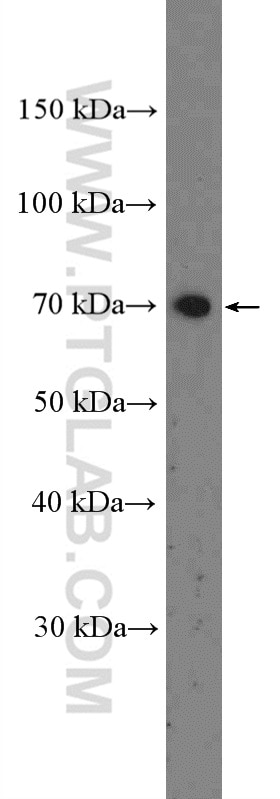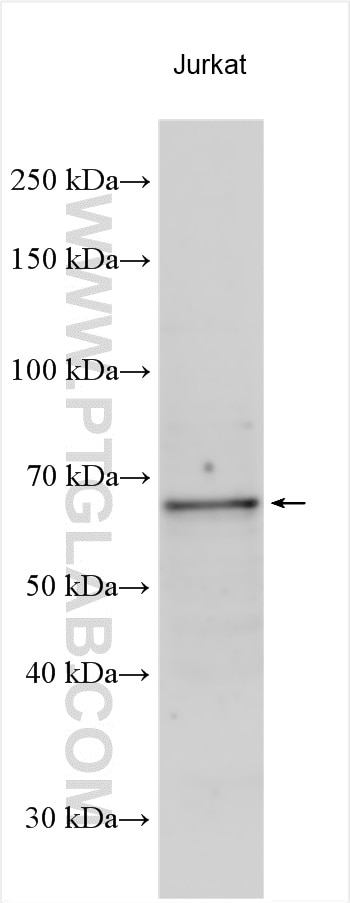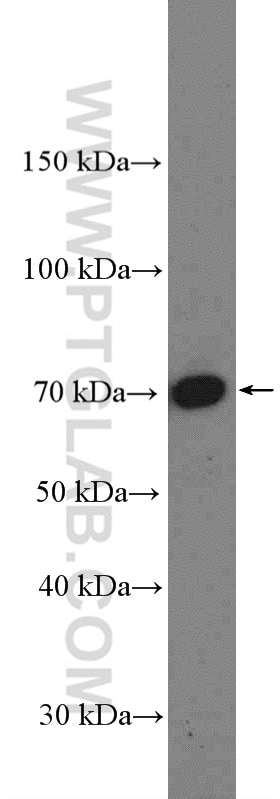MLLT3/AF9 Polyklonaler Antikörper
MLLT3/AF9 Polyklonal Antikörper für WB, ELISA
Wirt / Isotyp
Kaninchen / IgG
Getestete Reaktivität
human, Maus, Ratte
Anwendung
WB, ELISA
Konjugation
Unkonjugiert
Kat-Nr. : 12825-1-AP
Synonyme
Geprüfte Anwendungen
| Erfolgreiche Detektion in WB | Jurkat-Zellen, HL-60-Zellen |
Empfohlene Verdünnung
| Anwendung | Verdünnung |
|---|---|
| Western Blot (WB) | WB : 1:500-1:1000 |
| It is recommended that this reagent should be titrated in each testing system to obtain optimal results. | |
| Sample-dependent, check data in validation data gallery | |
Produktinformation
12825-1-AP bindet in WB, ELISA MLLT3/AF9 und zeigt Reaktivität mit human, Maus, Ratten
| Getestete Reaktivität | human, Maus, Ratte |
| Wirt / Isotyp | Kaninchen / IgG |
| Klonalität | Polyklonal |
| Typ | Antikörper |
| Immunogen | MLLT3/AF9 fusion protein Ag3528 |
| Vollständiger Name | myeloid/lymphoid or mixed-lineage leukemia (trithorax homolog, Drosophila); translocated to, 3 |
| Berechnetes Molekulargewicht | 568 aa, 63 kDa |
| Beobachtetes Molekulargewicht | 63-70 kDa |
| GenBank-Zugangsnummer | BC036089 |
| Gene symbol | AF9/MLLT3 |
| Gene ID (NCBI) | 4300 |
| Konjugation | Unkonjugiert |
| Form | Liquid |
| Reinigungsmethode | Antigen-Affinitätsreinigung |
| Lagerungspuffer | PBS with 0.02% sodium azide and 50% glycerol |
| Lagerungsbedingungen | Bei -20°C lagern. Nach dem Versand ein Jahr lang stabil Aliquotieren ist bei -20oC Lagerung nicht notwendig. 20ul Größen enthalten 0,1% BSA. |
Hintergrundinformationen
MLLT3, also named as AF9, YEATS3, is a 568 amino acid protein, which is a component of the superelongation complex6 and co-operates with DOT1L, which di/trimethylates H3K79 to promote transcription. MLLT3 localizes to active transcription start sites (TSSs) through the YEATS domain, which recognizes active histone marks such as H3K9 acetylation and crotonylation. A truncated MLLT3 that lacks the YEATS domain forms a leukaemic fusion protein with the N terminus of MLL1, which misdirects MLLT3-interacting complexes to induce aberrant gene transcription. MLLT3 also regulates erythroid or megakaryocytic progenitors and was identified as a definitive HSC hub gene during mouse development. Researcher found that the expression of a gene called MLLT3 was closely correlated with blood stem cells'potential to self-renew and that the protein generated by the MLLT3 gene provides blood stem cells with the instructions necessary to maintain its ability to self-renew. It does this by working with other regulatory proteins to keep important parts of the blood stem cell's machinery operational as the cells divide.
Protokolle
| PRODUKTSPEZIFISCHE PROTOKOLLE | |
|---|---|
| WB protocol for MLLT3/AF9 antibody 12825-1-AP | Protokoll herunterladen |
| STANDARD-PROTOKOLLE | |
|---|---|
| Klicken Sie hier, um unsere Standardprotokolle anzuzeigen |




